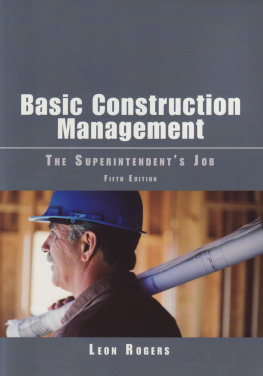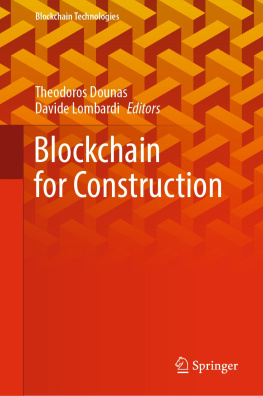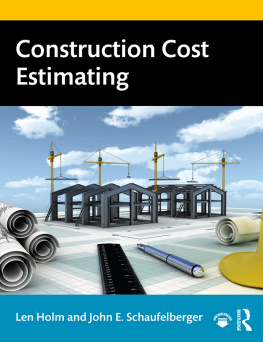Springer Tracts in Civil Engineering
Series Editors
Sheng-Hong Chen
School of Water Resources and Hydropower Engineering, Wuhan University, Wuhan, China
Marco di Prisco
Politecnico di Milano, Milano, Italy
Ioannis Vayas
Institute of Steel Structures, National Technical University of Athens, Athens, Greece
Springer Tracts in Civil Engineering (STCE) publishes the latest developments in Civil Engineering - quickly, informally and in top quality. The series scope includes monographs, professional books, graduate textbooks and edited volumes, as well as outstanding PhD theses. Its goal is to cover all the main branches of civil engineering, both theoretical and applied, including:
Construction and Structural Mechanics
Building Materials
Concrete, Steel and Timber Structures
Geotechnical Engineering
Earthquake Engineering
Coastal Engineering; Ocean and Offshore Engineering
Hydraulics, Hydrology and Water Resources Engineering
Environmental Engineering and Sustainability
Structural Health and Monitoring
Surveying and Geographical Information Systems
Heating, Ventilation and Air Conditioning (HVAC)
Transportation and Traffic
Risk Analysis
Safety and Security
Indexed by Scopus
To submit a proposal or request further information, please contact:
Pierpaolo Riva at Pierpaolo.Riva@springer.com (Europe and Americas) Wayne Hu at wayne.hu@springer.com (China)
More information about this series at http://www.springer.com/series/15088
Omoseni Adepoju , Clinton Aigbavboa , Nnamdi Nwulu and Michael Onyia
Re-skilling Human Resources for Construction 4.0
Implications for Industry, Academia and Government
1st ed. 2022

Logo of the publisher
Omoseni Adepoju
Faculty of Engineering and the Built Environment, University of Johannesburg, Johannesburg, South Africa
Clinton Aigbavboa
Faculty of Engineering and the Built Environment, University of Johannesburg, Johannesburg, South Africa
Nnamdi Nwulu
Department of Electrical and Electronic Engineering Science, University of Johannesburg, Johannesburg, South Africa
Michael Onyia
Department of Civil Engineering, University of Nigeria, Nsukka, Nigeria
ISSN 2366-259X e-ISSN 2366-2603
Springer Tracts in Civil Engineering
ISBN 978-3-030-85972-5 e-ISBN 978-3-030-85973-2
https://doi.org/10.1007/978-3-030-85973-2
The Editor(s) (if applicable) and The Author(s), under exclusive license to Springer Nature Switzerland AG 2022
This work is subject to copyright. All rights are solely and exclusively licensed by the Publisher, whether the whole or part of the material is concerned, specifically the rights of translation, reprinting, reuse of illustrations, recitation, broadcasting, reproduction on microfilms or in any other physical way, and transmission or information storage and retrieval, electronic adaptation, computer software, or by similar or dissimilar methodology now known or hereafter developed.
The use of general descriptive names, registered names, trademarks, service marks, etc. in this publication does not imply, even in the absence of a specific statement, that such names are exempt from the relevant protective laws and regulations and therefore free for general use.
The publisher, the authors and the editors are safe to assume that the advice and information in this book are believed to be true and accurate at the date of publication. Neither the publisher nor the authors or the editors give a warranty, expressed or implied, with respect to the material contained herein or for any errors or omissions that may have been made. The publisher remains neutral with regard to jurisdictional claims in published maps and institutional affiliations.
This Springer imprint is published by the registered company Springer Nature Switzerland AG
The registered company address is: Gewerbestrasse 11, 6330 Cham, Switzerland
Preface
The fourth industrial revolution, also known as Industry 4.0, has transformed the construction industry by creating digital, smart and sustainable construction technologies. The innovative deployment of Industry 4.0 concepts and its application in the construction industry is called Construction 4.0. These new technologies such as Building Information Modelling (BIM), Robotics, 3D printing and Drones give the professionals in the industry a different outlook about optimising their operations to boost the delivery of cost-effective, timely and quality projects. The application of these technologies comes with several benefits and some risks. More importantly, the adoption of these technologies demand new skills for its operation and effective performance.
In order to realise the benefits of these modern technologies, the construction industry needs to address the inevitable challenges, especially those pertaining to human resources. The availability of required skills will improve the implementation of Construction 4.0 technologies. Consequently, it becomes necessary to develop and build talents for the present and future needs of the industry. In line with this, the stakeholders in the industry have roles to play in building the necessary capabilities required to rapidly adapt to the new technologies. The industry is responsible for training the workers, creating a learning environment for practical application of the new technologies and working closely with educational institutions to equip personnel with the required knowledge and skills for Construction 4.0. Also, educational and training institutions with the collaboration of the industry are required to design courses and training programmes that can help nurture, develop and re-skill the human resources suited for a digitalised construction industry.
Furthermore, the governments have a responsibility in policy formulation to reinforce human capital development both at the educational institutions and the workplace. Hence, this research book will examine the key technologies of Construction 4.0, the benefits, risks and relevant skills required to implement the technologies. The book will also consider human resources reskilling needs and the roles of key stakeholders in developing the skills needed for Construction 4.0. This research views the lack of twenty-first century skills and the skills gap, especially in developing countries, as a limiting factor to implementing these technologies.
Omoseni Adepoju
Clinton Aigbavboa
Nnamdi Nwulu
Michael Onyia
Johannesburg, South Africa Johannesburg, South Africa Johannesburg, South Africa Nsukka, Nigeria
Contents
Part I Introduction and Background to Reskilling and Upskilling for Construction 4.0 Technologies
Part II Construction 4.0 Technologies
Part III Reskilling and Roles of Stakeholders for Implementation of Construction 4.0












